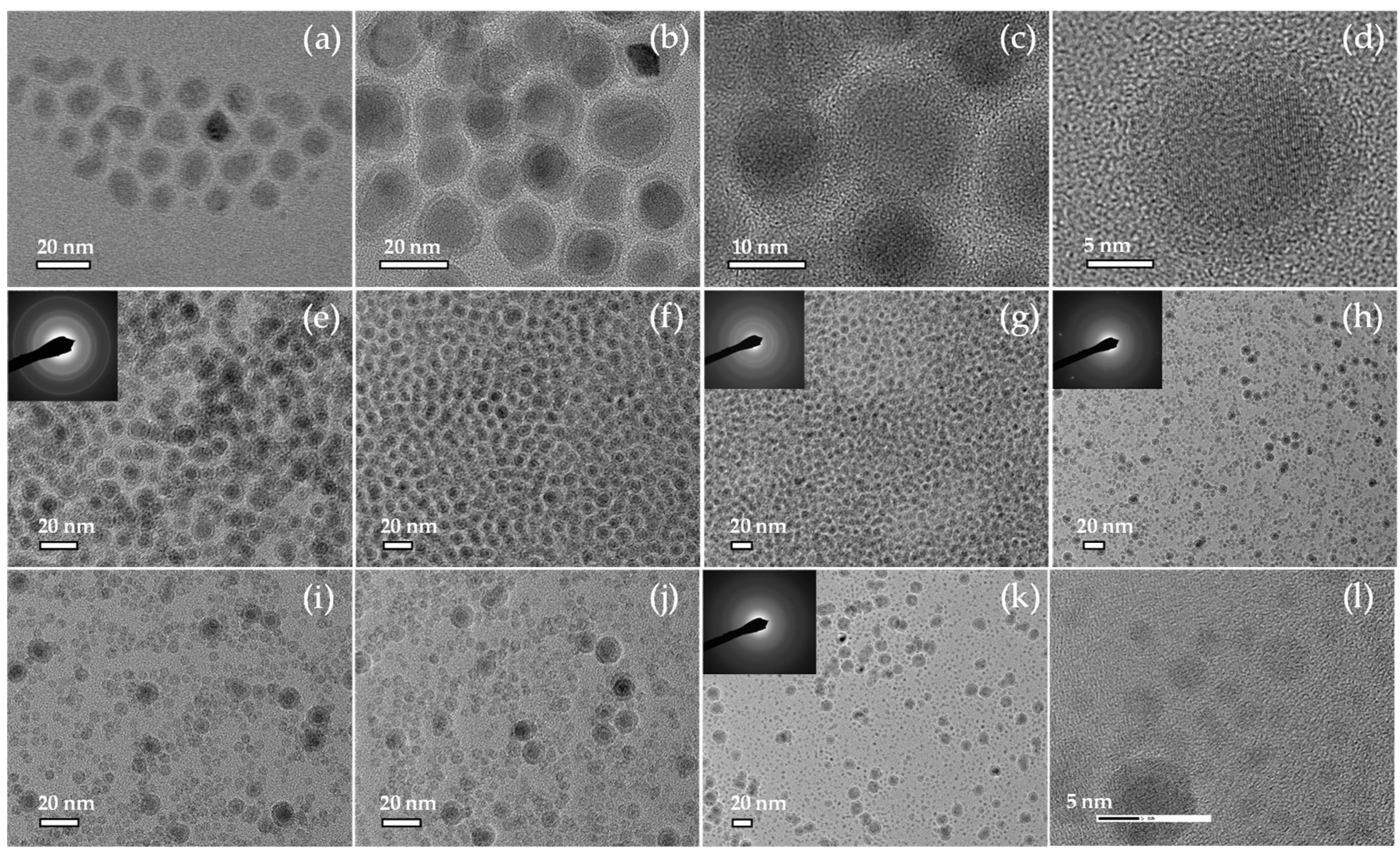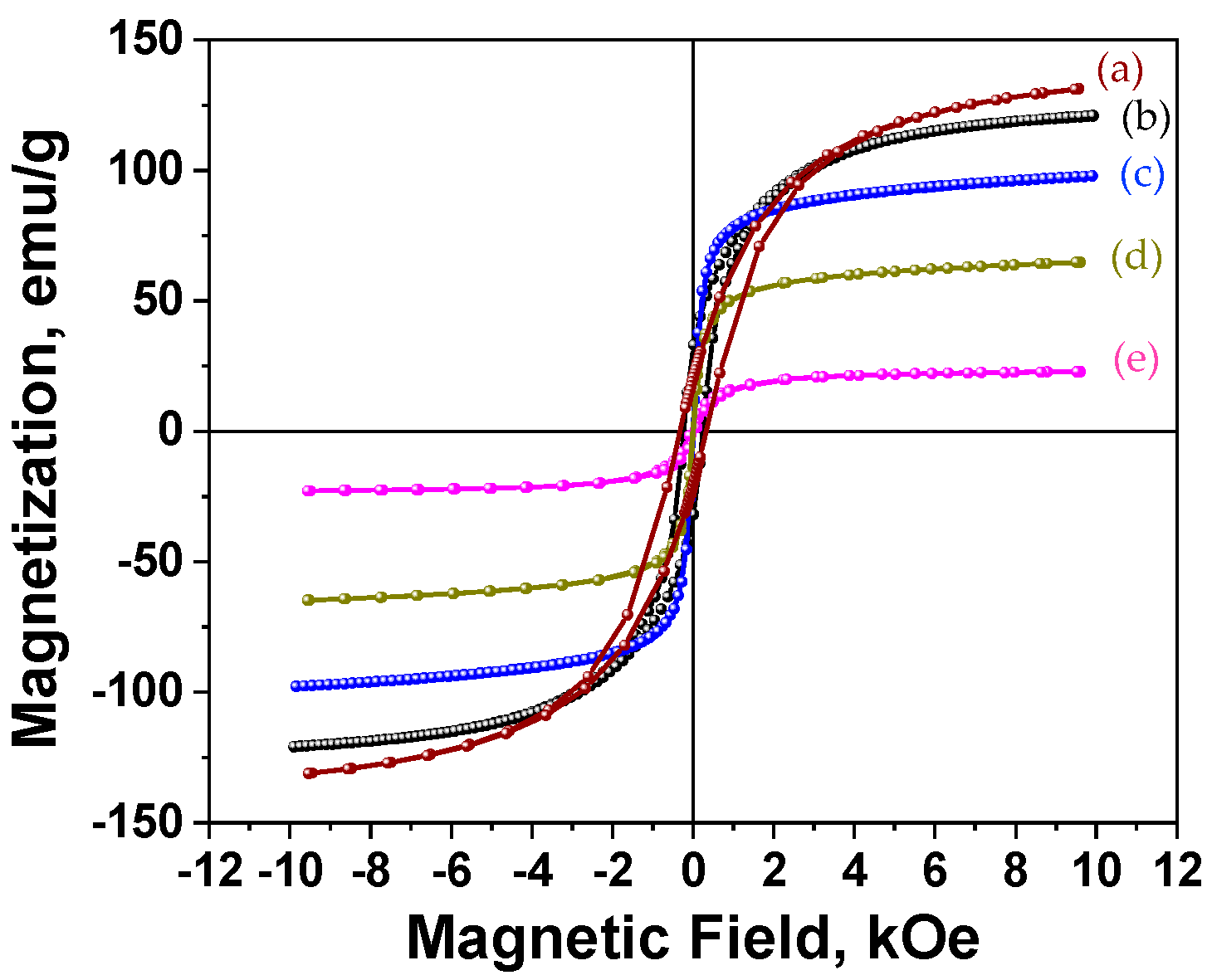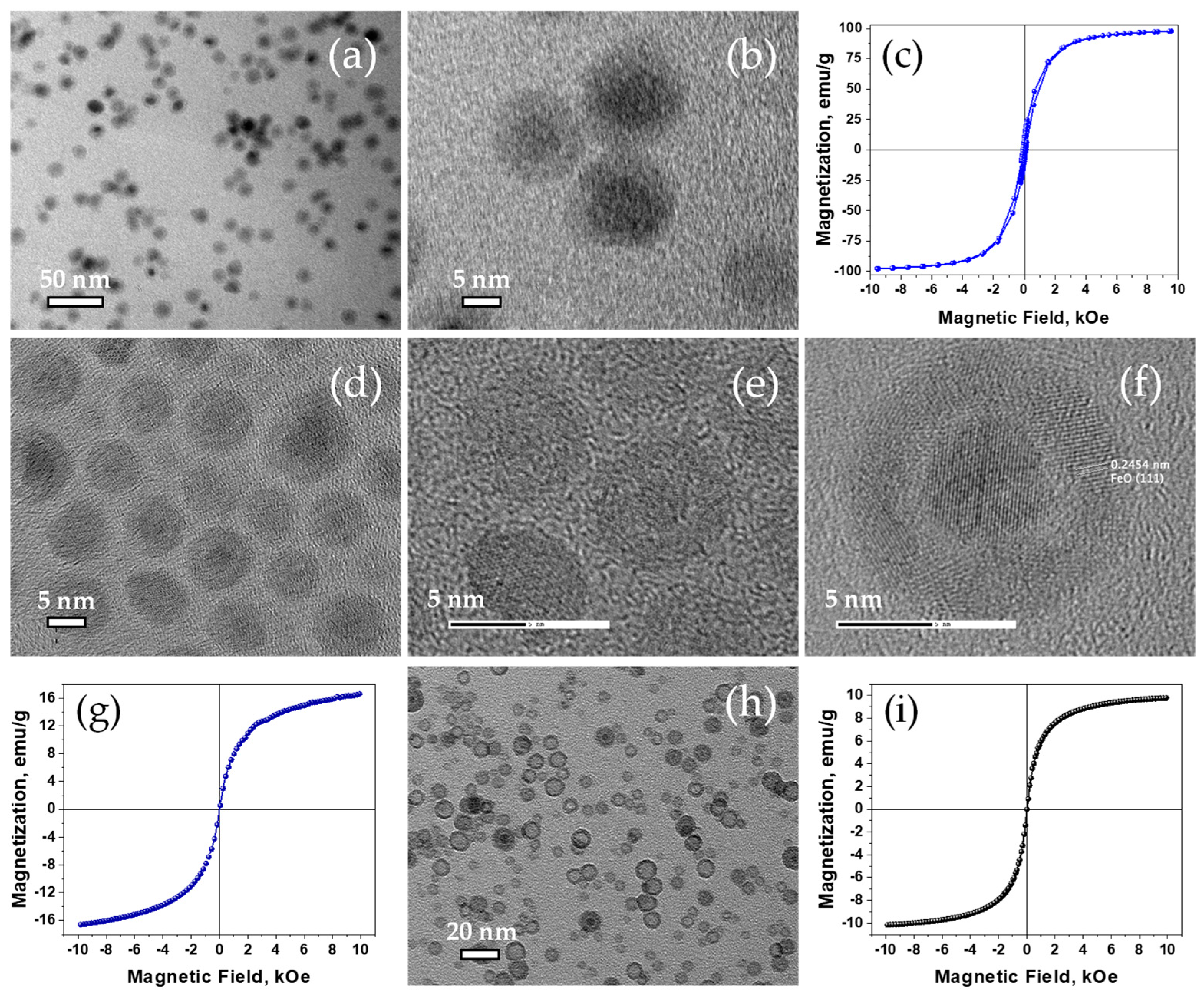Facile Organometallic Synthesis of Fe-Based Nanomaterials by Hot Injection Reaction
Abstract
1. Introduction
2. Materials and Methods
2.1. Materials Synthesis
2.2. Analytical Methods
3. Results and Discussion
4. Conclusions
Supplementary Materials
Author Contributions
Funding
Conflicts of Interest
References
- Sun, S.; Murray, C.B.; Weller, D.; Folks, L.; Moser, A. Monodisperse FePt Nanoparticles and Ferromagnetic FePt Nanocrystal Superlattices. Science 2000, 287, 1989. [Google Scholar] [CrossRef] [PubMed]
- Tzitzios, V.; Niarchos, D.; Hadjipanayis, G.; Devlin, E.; Petridis, D. Synthesis and Characterization of L10 FePt Nanoparticles from Pt(Au, Ag)/γ-Fe2O3 Core–Shell Nanoparticles. Adv. Mater. 2005, 17, 2188–2192. [Google Scholar] [CrossRef]
- Odenbach, S. Ferrofluids: Magnetically Controllable Fluids and Their Applications; Springer: Berlin/Heidelberg, Germany, 2002; Volume 594. [Google Scholar] [CrossRef]
- Tzitzios, V.; Basina, G.; Bakandritsos, A.; Hadjipanayis, C.G.; Mao, H.; Niarchos, D.; Hadjipanayis, G.C.; Tucek, J.; Zboril, R. Immobilization of magnetic iron oxide nanoparticles on laponite discs—An easy way to biocompatible ferrofluids and ferrogels. J. Mater. Chem. 2010, 20, 5418–5428. [Google Scholar] [CrossRef] [PubMed]
- Theis-Bröhl, K.; Saini, A.; Wolff, M.; Dura, J.A.; Maranville, B.B.; Borchers, J.A. Self-Assembly of Magnetic Nanoparticles in Ferrofluids on Different Templates Investigated by Neutron Reflectometry. Nanomaterials 2020, 10, 1231. [Google Scholar] [CrossRef] [PubMed]
- Hadjipanayis, C.G.; Bonder, M.J.; Balakrishnan, S.; Wang, X.; Mao, H.; Hadjipanayis, G.C. Metallic Iron Nanoparticles for MRI Contrast Enhancement and Local Hyperthermia. Small 2008, 4, 1925–1929. [Google Scholar] [CrossRef] [PubMed]
- Khurshid, H.; Hadjipanayis, C.G.; Chen, H.; Li, W.; Mao, H.; Machaidze, R.; Tzitzios, V.; Hadjipanayis, G.C. Core/shell structured iron/iron-oxide nanoparticles as excellent MRI contrast enhancement agents. J. Magn. Magn. Mater. 2013, 331, 17–20. [Google Scholar] [CrossRef]
- Basina, G.; Tzitzios, V.; Niarchos, D.; Li, W.; Khurshid, H.; Mao, H.; Hadjipanayis, C.; Hadjipanayis, G. Water-Soluble Spinel Ferrites by a Modified Polyol Process as Contrast Agents in MRI. AIP Conf. Proc. 2010, 1311, 441–446. [Google Scholar] [CrossRef]
- Tong, S.; Zhu, H.; Bao, G. Magnetic iron oxide nanoparticles for disease detection and therapy. Mater. Today 2019, 31, 86–99. [Google Scholar] [CrossRef] [PubMed]
- Yu, X.; Ding, S.; Yang, R.; Wu, C.; Zhang, W. Research progress on magnetic nanoparticles for magnetic induction hyperthermia of malignant tumor. Ceram. Int. 2021, 47, 5909–5917. [Google Scholar] [CrossRef]
- Jain, T.K.; Morales, M.A.; Sahoo, S.K.; Leslie-Pelecky, D.L.; Labhasetwar, V. Iron Oxide Nanoparticles for Sustained Delivery of Anticancer Agents. Mol. Pharm. 2005, 2, 194–205. [Google Scholar] [CrossRef] [PubMed]
- Basina, G.; Mountrichas, G.; Devlin, E.; Boukos, N.; Niarchos, D.; Petridis, D.; Pispas, S.; Tzitzios, V. Synthesis and magnetic properties of Fe3O4 nanoparticles coated with biocompatible double hydrophilic block copolymer. J. Nanosci. Nanotechnol. 2009, 98, 4753–4759. [Google Scholar] [CrossRef] [PubMed]
- Bakandritsos, A.; Mattheolabakis, G.; Chatzikyriakos, G.; Szabo, T.; Tzitzios, V.; Kouzoudis, D.; Couris, S.; Avgoustakis, K. Doxorubicin Nanocarriers Based on Magnetic Colloids with a Bio-polyelectrolyte Corona and High Non-linear Optical Response: Synthesis, Characterization, and Properties. Adv. Funct. Mater. 2011, 21, 1465–1475. [Google Scholar] [CrossRef]
- Liu, T.-Y.; Hu, S.-H.; Liu, T.-Y.; Liu, D.-M.; Chen, S.-Y. Magnetic-Sensitive Behavior of Intelligent Ferrogels for Controlled Release of Drug. Langmuir 2006, 22, 5974–5978. [Google Scholar] [CrossRef] [PubMed]
- Son, S.J.; Reichel, J.; He, B.; Schuchman, M.; Lee, S.B. Magnetic Nanotubes for Magnetic-Field-Assisted Bioseparation, Biointeraction, and Drug Delivery. J. Am. Chem. Soc. 2005, 127, 7316–7317. [Google Scholar] [CrossRef] [PubMed]
- Safarik, I.; Safarikova, M. Magnetic techniques for the isolation and purification of proteins and peptides. BioMagn. Res. Technol. 2004, 2, 7. [Google Scholar] [CrossRef] [PubMed]
- Frodsham, G.; Pankhurst, Q.A. Biomedical applications of high gradient magnetic separation: Progress towards therapeutic haeomofiltration. Biomed. Eng. Biomed. Tech. 2015, 60, 393–404. [Google Scholar] [CrossRef] [PubMed]
- Prasad, N.K.; Rathinasamy, K.; Panda, D.; Bahadur, D. Mechanism of cell death induced by magnetic hyperthermia with nanoparticles of γ-MnxFe2–xO3 synthesized by a single step process. J. Mater. Chem. 2007, 17, 5042–5051. [Google Scholar] [CrossRef]
- Thomas, L.A.; Dekker, L.; Kallumadil, M.; Southern, P.; Wilson, M.; Nair, S.P.; Pankhurst, Q.A.; Parkin, I.P. Carboxylic acid-stabilised iron oxide nanoparticles for use in magnetic hyperthermia. J. Mater. Chem. 2009, 19, 6529–6535. [Google Scholar] [CrossRef]
- Drake, P.; Cho, H.-J.; Shih, P.-S.; Kao, C.-H.; Lee, K.-F.; Kuo, C.-H.; Lin, X.-Z.; Lin, Y.-J. Gd-doped iron-oxide nanoparticles for tumour therapy via magnetic field hyperthermia. J. Mater. Chem. 2007, 17, 4914–4918. [Google Scholar] [CrossRef]
- Pourmiri, S.; Tzitzios, V.; Hadjipanayis, G.C.; Meneses Brassea, B.P.; El-Gendy, A.A. Magnetic properties and hyperthermia behavior of iron oxide nanoparticle clusters. AIP Adv. 2019, 9, 125033. [Google Scholar] [CrossRef]
- Diamantopoulos, G.; Basina, G.; Tzitzios, V.; Karakosta, E.; Fardis, M.; Jaglicic, Z.; Lazaridis, N.; Papavassiliou, G. Magnetic hyperthermia of laponite based ferrofluid. J. Magn. Magn. Mater. 2013, 336, 71–74. [Google Scholar] [CrossRef]
- Haija, M.A.; Basina, G.; Banat, F.; Ayesh, A.I. Adsorption and gas sensing properties of CuFe2O4 nanoparticles. Mater. Sci. Pol. 2019, 37, 289–295. [Google Scholar] [CrossRef]
- Gloag, L.; Mehdipour, M.; Chen, D.; Tilley, R.D.; Gooding, J.J. Advances in the Application of Magnetic Nanoparticles for Sensing. Adv. Mater. 2019, 31, 1904385. [Google Scholar] [CrossRef] [PubMed]
- Rocha-Santos, T.A.P. Sensors and biosensors based on magnetic nanoparticles. TrAC Trends Anal. Chem. 2014, 62, 28–36. [Google Scholar] [CrossRef]
- Van Der Laan, G.P.; Beenackers, A.A.C.M. Kinetics and Selectivity of the Fischer–Tropsch Synthesis: A Literature Review. Catal. Rev. 1999, 41, 255–318. [Google Scholar] [CrossRef]
- González-Rodríguez, J.; Fernández, L.; Vargas-Osorio, Z.; Vázquez-Vázquez, C.; Piñeiro, Y.; Rivas, J.; Feijoo, G.; Moreira, M.T. Reusable Fe3O4/SBA15 Nanocomposite as an Efficient Photo-Fenton Catalyst for the Removal of Sulfamethoxazole and Orange II. Nanomaterials 2021, 11, 533. [Google Scholar] [CrossRef] [PubMed]
- Basina, G.; Elmutasim, O.; Gaber, D.A.; Gaber, S.A.; Lu, X.; Tzitzios, V.; Vaithilingam, B.V.; Baikousi, M.; Asimakopoulos, G.; Karakassides, M.A.; et al. On the selective oxidation of H2S by heavy loaded Nanoparticles Embedded in Mesoporous Matrix (NEMMs). Appl. Catal. B Environ. 2020, 278, 119338. [Google Scholar] [CrossRef]
- Zhang, M.; Ma, Z.; Song, H. Preparation and Application of Fe-N Co-Doped GNR@CNT Cathode Oxygen Reduction Reaction Catalyst in Microbial Fuel Cells. Nanomaterials 2021, 11, 377. [Google Scholar] [CrossRef] [PubMed]
- Tzitzios, V.K.; Bakandritsos, A.; Georgakilas, V.; Basina, G.; Boukos, N.; Bourlinos, A.B.; Niarchos, D.; Petridis, D. Large-Scale Synthesis, Size Control, and Anisotropic Growth of gamma-Fe2O3 Nanoparticles: Organosols and Hydrosols. J. Nanosci. Nanotechnol. 2007, 7, 2753–2757. [Google Scholar] [CrossRef] [PubMed]
- Sharma, P.; Holliger, N.; Pfromm, P.H.; Liu, B.; Chikan, V. Size-Controlled Synthesis of Iron and Iron Oxide Nanoparticles by the Rapid Inductive Heating Method. ACS Omega 2020, 5, 19853–19860. [Google Scholar] [CrossRef] [PubMed]
- Sayed, F.N.; Polshettiwar, V. Facile and Sustainable Synthesis of Shaped Iron Oxide Nanoparticles: Effect of Iron Precursor Salts on the Shapes of Iron Oxides. Sci. Rep. 2015, 5, 9733. [Google Scholar] [CrossRef] [PubMed]
- Farrell, D.; Majetich, S.A.; Wilcoxon, J.P. Preparation and Characterization of Monodisperse Fe Nanoparticles. J. Phys. Chem. B 2003, 107, 11022–11030. [Google Scholar] [CrossRef]
- Nurmi, J.T.; Tratnyek, P.G.; Sarathy, V.; Baer, D.R.; Amonette, J.E.; Pecher, K.; Wang, C.; Linehan, J.C.; Matson, D.W.; Penn, R.L.; et al. Characterization and Properties of Metallic Iron Nanoparticles: Spectroscopy, Electrochemistry, and Kinetics. Environ. Sci. Technol. 2005, 39, 1221–1230. [Google Scholar] [CrossRef] [PubMed]
- Watt, J.; Bleier, G.C.; Austin, M.J.; Ivanov, S.A.; Huber, D.L. Non-volatile iron carbonyls as versatile precursors for the synthesis of iron-containing nanoparticles. Nanoscale 2017, 9, 6632–6637. [Google Scholar] [CrossRef] [PubMed]
- Tzitzios, V.; Basina, G.; Gjoka, M.; Boukos, N.; Niarchos, D.; Devlin, E.; Petridis, D. The effect of Mn doping in FePt nanoparticles on the magnetic properties of the L10phase. Nanotechnology 2006, 17, 4270–4273. [Google Scholar] [CrossRef] [PubMed]
- Tzitzios, V.; Basina, G.; Niarchos, D.; Li, W.; Hadjipanayis, G. Synthesis of air stable FeCo nanoparticles. J. Appl. Phys. 2011, 109, 07A313. [Google Scholar] [CrossRef]
- Wu, A.; Yang, X.; Yang, H. Magnetic properties of carbon-encapsulated Fe–Co alloy nanoparticles. Dalton Trans. 2013, 42, 4978–4984. [Google Scholar] [CrossRef] [PubMed]
- LaGrow, A.P.; Besenhard, M.O.; Hodzic, A.; Sergides, A.; Bogart, L.K.; Gavriilidis, A.; Thanh, N.T.K. Unravelling the growth mechanism of the co-precipitation of iron oxide nanoparticles with the aid of synchrotron X-ray diffraction in solution. Nanoscale 2019, 11, 6620–6628. [Google Scholar] [CrossRef] [PubMed]
- Tzitzios, V.; Niarchos, D.; Margariti, G.; Fidler, J.; Petridis, D. Synthesis of CoPt nanoparticles by a modified polyol method: Characterization and magnetic properties. Nanotechnology 2005, 16, 287–291. [Google Scholar] [CrossRef] [PubMed]
- Panagiotopoulos, I.; Alexandrakis, V.; Basina, G.; Pal, S.; Srikanth, H.; Niarchos, D.; Hadjipanayis, G.; Tzitzios, V. Synthesis and Magnetic Properties of Pure Cubic CoO Nanocrystals and Nanoaggregates. Cryst. Growth Des. 2009, 9, 3353–3358. [Google Scholar] [CrossRef]
- Tzitzios, V.; Basina, G.; Gjoka, M.; Alexandrakis, V.; Georgakilas, V.; Niarchos, D.; Boukos, N.; Petridis, D. Chemical synthesis and characterization of hcp Ni nanoparticles. Nanotechnology 2006, 17, 3750–3755. [Google Scholar] [CrossRef]
- Tzitzios, V.; Georgakilas, V.; Zafiropoulou, I.; Boukos, N.; Basina, G.; Niarchos, D.; Petridis, D. A General Chemical Route for the Synthesis of Capped Nanocrystalline Materials. J. Nanosci. Nanotechnol. 2008, 8, 3117–3122. [Google Scholar] [CrossRef] [PubMed]
- Unni, M.; Uhl, A.M.; Savliwala, S.; Savitzky, B.H.; Dhavalikar, R.; Garraud, N.; Arnold, D.P.; Kourkoutis, L.F.; Andrew, J.S.; Rinaldi, C. Thermal Decomposition Synthesis of Iron Oxide Nanoparticles with Diminished Magnetic Dead Layer by Controlled Addition of Oxygen. ACS Nano 2017, 11, 2284–2303. [Google Scholar] [CrossRef] [PubMed]
- Andrade, R.G.D.; Veloso, S.R.S.; Castanheira, E.M.S. Shape Anisotropic Iron Oxide-Based Magnetic Nanoparticles: Synthesis and Biomedical Applications. Int. J. Mol. Sci. 2020, 21, 2455. [Google Scholar] [CrossRef] [PubMed]
- Panagiotopoulos, I.; Basina, G.; Alexandrakis, V.; Devlin, E.; Hadjipanayis, G.; Colak, L.; Niarchos, D.; Tzitzios, V. Synthesis and Exchange Bias in γ-Fe2O3/CoO and Reverse CoO/γ-Fe2O3 Binary Nanoparticles. J. Phys. Chem. C 2009, 113, 14609–14614. [Google Scholar] [CrossRef]
- Guardia, P.; Labarta, A.; Batlle, X. Tuning the Size, the Shape, and the Magnetic Properties of Iron Oxide Nanoparticles. J. Phys. Chem. C 2011, 115, 390–396. [Google Scholar] [CrossRef]
- Peng, S.; Wang, C.; Xie, J.; Sun, S. Synthesis and Stabilization of Monodisperse Fe Nanoparticles. J. Am. Chem. Soc. 2006, 128, 10676–10677. [Google Scholar] [CrossRef] [PubMed]
- Khurshid, H.; Tzitzios, V.; Li, W.; Hadjipanayis, C.G.; Hadjipanayis, G.C. Size and composition control of core-shell structured iron/iron-oxide nanoparticles. J. Appl. Phys. 2010, 107, 09A333. [Google Scholar] [CrossRef]
- Yang, H.; Ito, F.; Hasegawa, D.; Ogawa, T.; Takahashi, M. Facile large-scale synthesis of monodisperse Fe nanoparticles by modest-temperature decomposition of iron carbonyl. J. Appl. Phys. 2007, 101, 09J112. [Google Scholar] [CrossRef]
- Kura, H.; Takahashi, M.; Ogawa, T. Synthesis of Monodisperse Iron Nanoparticles with a High Saturation Magnetization Using an Fe(CO)x−Oleylamine Reacted Precursor. J. Phys. Chem. C 2010, 114, 5835–5838. [Google Scholar] [CrossRef]
- Dumestre, F.; Chaudret, B.; Amiens, C.; Renaud, P.; Fejes, P. Superlattices of Iron Nanocubes Synthesized from Fe[N(SiMe3)2]2. Science 2004, 303, 821. [Google Scholar] [CrossRef] [PubMed]
- Wilcoxon, J.P.; Provencio, P.P. Use of Surfactant Micelles to Control the Structural Phase of Nanosize Iron Clusters. J. Phys. Chem. B 1999, 103, 9809–9812. [Google Scholar] [CrossRef]
- Yamamuro, S.; Ando, T.; Sumiyama, K.; Uchida, T.; Kojima, I. Monodisperse Metallic Iron Nanoparticles Synthesized from Noncarbonyl Complex. Jpn. J. Appl. Phys. 2004, 43, 4458–4459. [Google Scholar] [CrossRef]
- Abel, F.M.; Pourmiri, S.; Basina, G.; Tzitzios, V.; Devlin, E.; Hadjipanayis, G.C. Iron carbide nanoplatelets: Colloidal synthesis and characterization. Nanoscale Adv. 2019, 1, 4476–4480. [Google Scholar] [CrossRef]
- Salgueiriño-Maceira, V.; Liz-Marzán, L.M.; Farle, M. Water-Based Ferrofluids from FexPt1−x Nanoparticles Synthesized in Organic Media. Langmuir 2004, 20, 6946–6950. [Google Scholar] [CrossRef] [PubMed]




Publisher’s Note: MDPI stays neutral with regard to jurisdictional claims in published maps and institutional affiliations. |
© 2021 by the authors. Licensee MDPI, Basel, Switzerland. This article is an open access article distributed under the terms and conditions of the Creative Commons Attribution (CC BY) license (https://creativecommons.org/licenses/by/4.0/).
Share and Cite
Basina, G.; Khurshid, H.; Tzitzios, N.; Hadjipanayis, G.; Tzitzios, V. Facile Organometallic Synthesis of Fe-Based Nanomaterials by Hot Injection Reaction. Nanomaterials 2021, 11, 1141. https://doi.org/10.3390/nano11051141
Basina G, Khurshid H, Tzitzios N, Hadjipanayis G, Tzitzios V. Facile Organometallic Synthesis of Fe-Based Nanomaterials by Hot Injection Reaction. Nanomaterials. 2021; 11(5):1141. https://doi.org/10.3390/nano11051141
Chicago/Turabian StyleBasina, Georgia, Hafsa Khurshid, Nikolaos Tzitzios, George Hadjipanayis, and Vasileios Tzitzios. 2021. "Facile Organometallic Synthesis of Fe-Based Nanomaterials by Hot Injection Reaction" Nanomaterials 11, no. 5: 1141. https://doi.org/10.3390/nano11051141
APA StyleBasina, G., Khurshid, H., Tzitzios, N., Hadjipanayis, G., & Tzitzios, V. (2021). Facile Organometallic Synthesis of Fe-Based Nanomaterials by Hot Injection Reaction. Nanomaterials, 11(5), 1141. https://doi.org/10.3390/nano11051141






